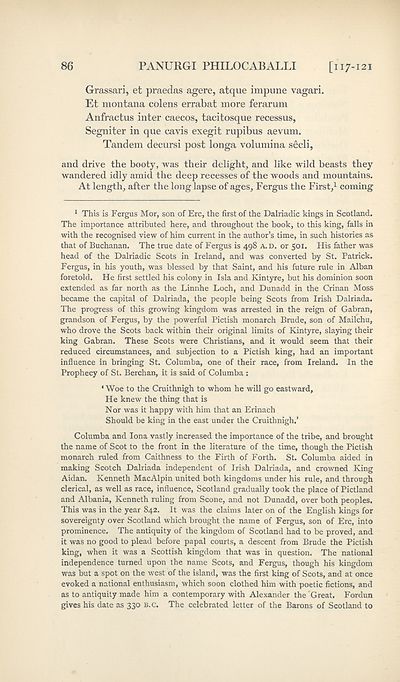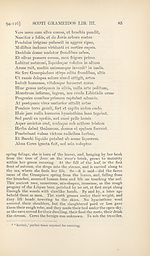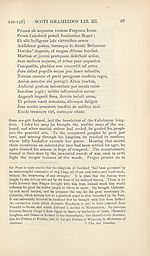Series 1 > Grameid: an heroic poem descriptive of the campaign of Viscount Dundee in 1689, and other pieces
(157) Page 86
Download files
Complete book:
Individual page:
Thumbnail gallery: Grid view | List view

86
PANURGI PHILOCABALLI [117-121
Grassari, et praedas agere, atque impune vagari.
Et montana colens errabat more ferarum
Anfractus inter caecos, tacitosque recessus,
Segniter in que cavis exegit rupibus aevum.
Tandem decursi post longa volumina secli,
and drive the booty, was their delight, and like wild beasts they
wandered idly amid the deep recesses of the woods and mountains.
At length, after the long lapse of ages, Fergus the First,1 coming
1 This is Fergus Mor, son of Ere, the first of the Dalriadic kings in Scotland.
The importance attributed here, and throughout the book, to this king, falls in
with the recognised view of him current in the author’s time, in such histories as
that of Buchanan. The true date of Fergus is 498 a.d. or 501. His father was
head of the Dalriadic Scots in Ireland, and was converted by St. Patrick.
Fergus, in his youth, was blessed by that Saint, and his future rule in Alban
foretold. He first settled his colony in Isla and Kintyre, but his dominion soon
extended as far north as the Linnhe Loch, and Dunadd in the Crinan Moss
became the capital of Dalriada, the people being Scots from Irish Dalriada.
The progress of this growing kingdom was arrested in the reign of Gabran,
grandson of Fergus, by the powerful Pictish monarch Brude, son of Mailchu,
who drove the Scots back within their original limits of Kintyre, slaying their
king Gabran. These Scots were Christians, and it would seem that their
reduced circumstances, and subjection to a Pictish king, had an important
influence in bringing St. Columba, one of their race, from Ireland. In the
Prophecy of St. Berchan, it is said of Columba :
‘ Woe to the Cruithnigh to whom he will go eastward.
He knew the thing that is
Nor was it happy with him that an Erinach
Should be king in the east under the Cruithnigh.’
Columba and Iona vastly increased the importance of the tribe, and brought
the name of Scot to the front in the literature of the time, though the Pictish
monarch ruled from Caithness to the Firth of Forth. St. Columba aided in
making Scotch Dalriada independent of Irish Dalriada, and crowned King
Aidan. Kenneth MacAlpin united both kingdoms under his rule, and through
clerical, as well as race, influence, Scotland gradually took the place of Pictland
and Albania, Kenneth ruling from Scone, and not Dunadd, over both peoples.
This was in the year 842. It was the claims later on of the English kings for
sovereignty over Scotland which brought the name of Fergus, son of Ere, into
prominence. The antiquity of the kingdom of Scotland had to be proved, and
it was no good to plead before papal courts, a descent from Brude the Pictish
king, when it was a Scottish kingdom that was in question. The national
independence turned upon the name Scots, and Fergus, though his kingdom
was but a spot on the west of the island, was the first king of Scots, and at once
evoked a national enthusiasm, which soon clothed him with poetic fictions, and
as to antiquity made him a contemporary with Alexander the Great. Fordun
gives his date as 330 b.c. The celebrated letter of the Barons of Scotland to
PANURGI PHILOCABALLI [117-121
Grassari, et praedas agere, atque impune vagari.
Et montana colens errabat more ferarum
Anfractus inter caecos, tacitosque recessus,
Segniter in que cavis exegit rupibus aevum.
Tandem decursi post longa volumina secli,
and drive the booty, was their delight, and like wild beasts they
wandered idly amid the deep recesses of the woods and mountains.
At length, after the long lapse of ages, Fergus the First,1 coming
1 This is Fergus Mor, son of Ere, the first of the Dalriadic kings in Scotland.
The importance attributed here, and throughout the book, to this king, falls in
with the recognised view of him current in the author’s time, in such histories as
that of Buchanan. The true date of Fergus is 498 a.d. or 501. His father was
head of the Dalriadic Scots in Ireland, and was converted by St. Patrick.
Fergus, in his youth, was blessed by that Saint, and his future rule in Alban
foretold. He first settled his colony in Isla and Kintyre, but his dominion soon
extended as far north as the Linnhe Loch, and Dunadd in the Crinan Moss
became the capital of Dalriada, the people being Scots from Irish Dalriada.
The progress of this growing kingdom was arrested in the reign of Gabran,
grandson of Fergus, by the powerful Pictish monarch Brude, son of Mailchu,
who drove the Scots back within their original limits of Kintyre, slaying their
king Gabran. These Scots were Christians, and it would seem that their
reduced circumstances, and subjection to a Pictish king, had an important
influence in bringing St. Columba, one of their race, from Ireland. In the
Prophecy of St. Berchan, it is said of Columba :
‘ Woe to the Cruithnigh to whom he will go eastward.
He knew the thing that is
Nor was it happy with him that an Erinach
Should be king in the east under the Cruithnigh.’
Columba and Iona vastly increased the importance of the tribe, and brought
the name of Scot to the front in the literature of the time, though the Pictish
monarch ruled from Caithness to the Firth of Forth. St. Columba aided in
making Scotch Dalriada independent of Irish Dalriada, and crowned King
Aidan. Kenneth MacAlpin united both kingdoms under his rule, and through
clerical, as well as race, influence, Scotland gradually took the place of Pictland
and Albania, Kenneth ruling from Scone, and not Dunadd, over both peoples.
This was in the year 842. It was the claims later on of the English kings for
sovereignty over Scotland which brought the name of Fergus, son of Ere, into
prominence. The antiquity of the kingdom of Scotland had to be proved, and
it was no good to plead before papal courts, a descent from Brude the Pictish
king, when it was a Scottish kingdom that was in question. The national
independence turned upon the name Scots, and Fergus, though his kingdom
was but a spot on the west of the island, was the first king of Scots, and at once
evoked a national enthusiasm, which soon clothed him with poetic fictions, and
as to antiquity made him a contemporary with Alexander the Great. Fordun
gives his date as 330 b.c. The celebrated letter of the Barons of Scotland to
Set display mode to:
![]() Universal Viewer |
Universal Viewer | ![]() Mirador |
Large image | Transcription
Mirador |
Large image | Transcription
Images and transcriptions on this page, including medium image downloads, may be used under the Creative Commons Attribution 4.0 International Licence unless otherwise stated. ![]()
| Scottish History Society volumes > Series 1 > Grameid: an heroic poem descriptive of the campaign of Viscount Dundee in 1689, and other pieces > (157) Page 86 |
|---|
| Permanent URL | https://digital.nls.uk/126597441 |
|---|
| Attribution and copyright: |
|
|---|
| Description | Over 180 volumes, published by the Scottish History Society, containing original sources on Scotland's history and people. With a wide range of subjects, the books collectively cover all periods from the 12th to 20th centuries, and reflect changing trends in Scottish history. Sources are accompanied by scholarly interpretation, references and bibliographies. Volumes are usually published annually, and more digitised volumes will be added as they become available. |
|---|


